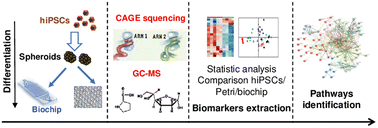Analysis of the transcriptome and metabolome of pancreatic spheroids derived from human induced pluripotent stem cells and matured in an organ-on-a-chip†
Abstract
Functional differentiation of pancreatic like tissue from human induced pluripotent stem cells is one of the emerging strategies to achieve an in vitro pancreas model. Here, we propose a protocol to cultivate hiPSC-derived β-like-cells coupling spheroids and microfluidic technologies to improve the pancreatic lineage maturation. The protocol led to the development of spheroids producing the C-peptide and containing cells positive to insulin and glucagon. In order to further characterize the cellular and molecular profiles, we performed full transcriptomics and metabolomics analysis. The omics analysis confirmed the activation of key transcription factors together with the upregulation of genes and the presence of metabolites involved in functional pancreatic tissue development, extracellular matrix remodeling, lipid and fatty acid metabolism, and endocrine hormone signaling. When compared to static 3D honeycomb cultures, dynamic 3D biochip cultures contributed to increase specifically the activity of the HIF transcription factor, to activate the calcium activated cation channels, to enrich the glucagon and insulin pathways and glycolysis/gluconeogenesis, and to increase the secretion of serotonin, glycerol and glycerol-3-phosphate at the metabolic levels.



 Please wait while we load your content...
Please wait while we load your content...